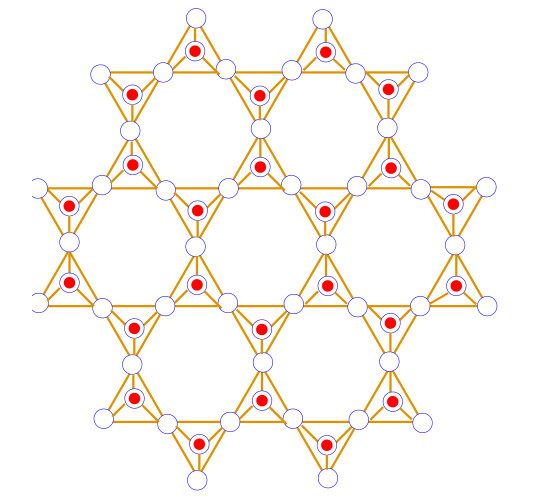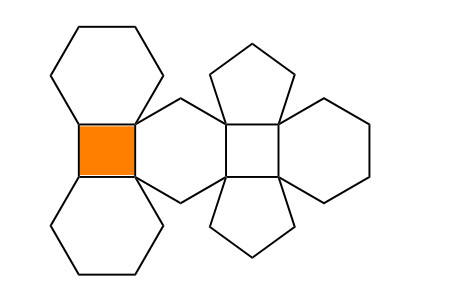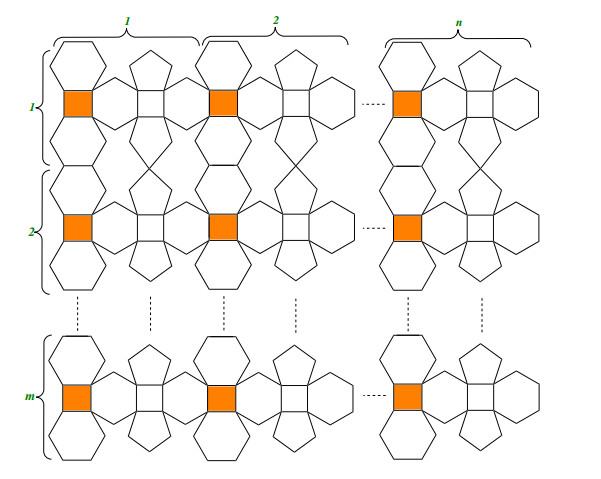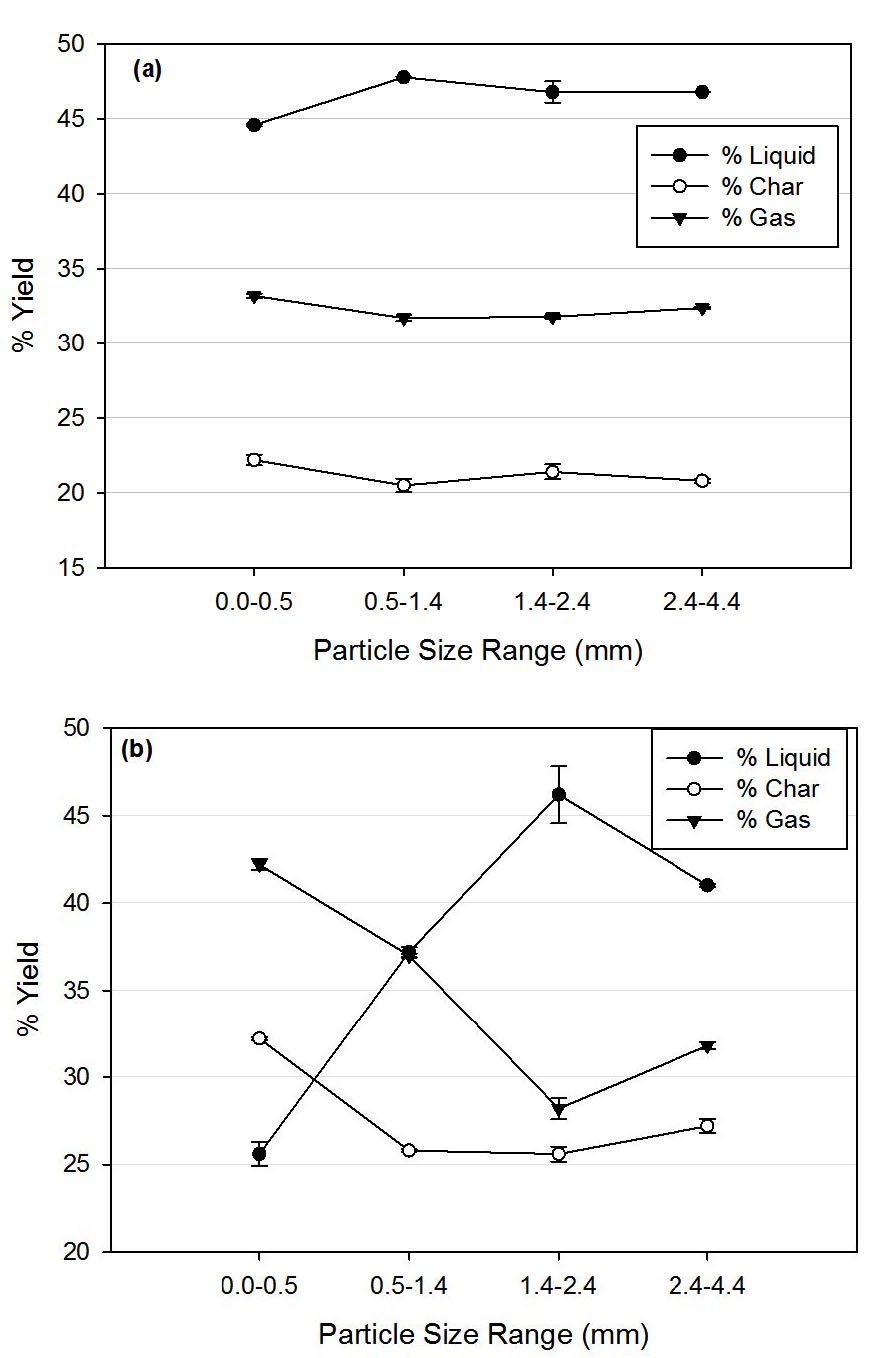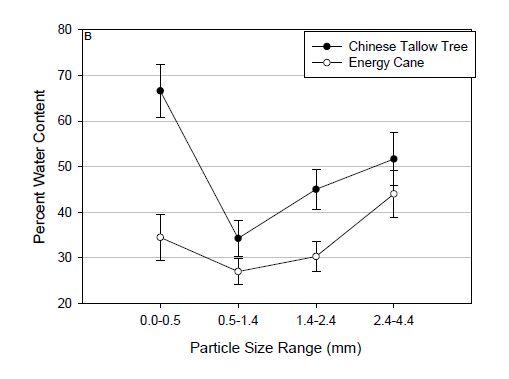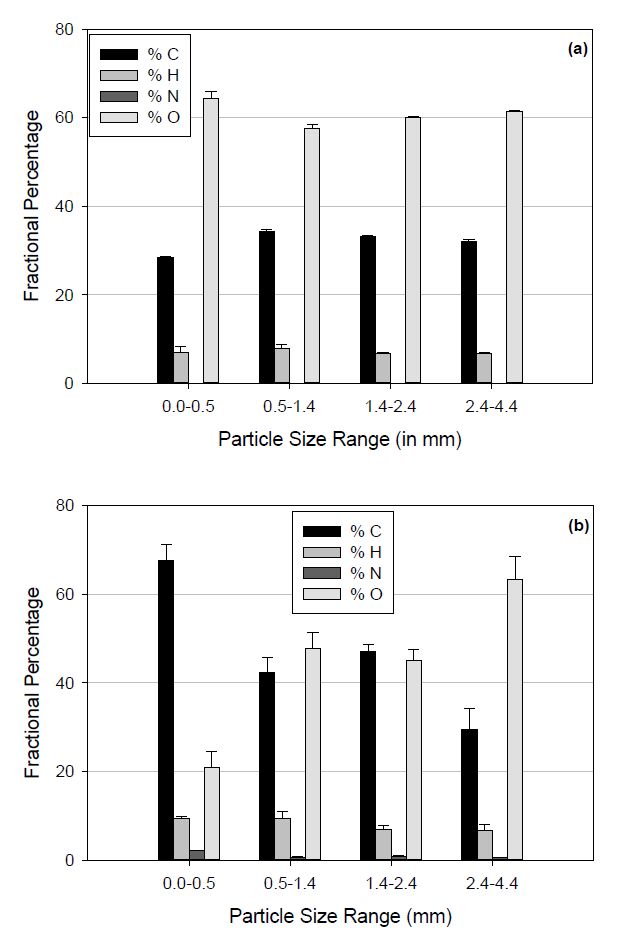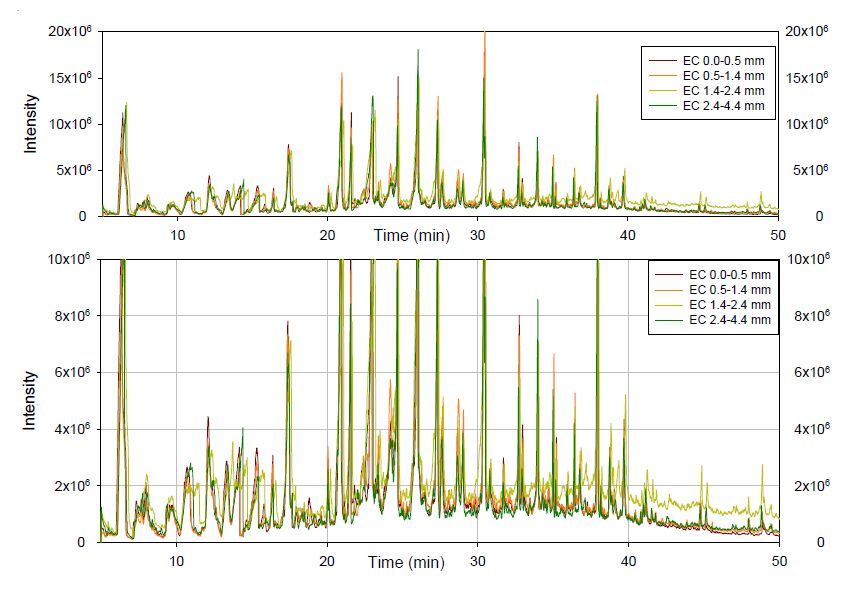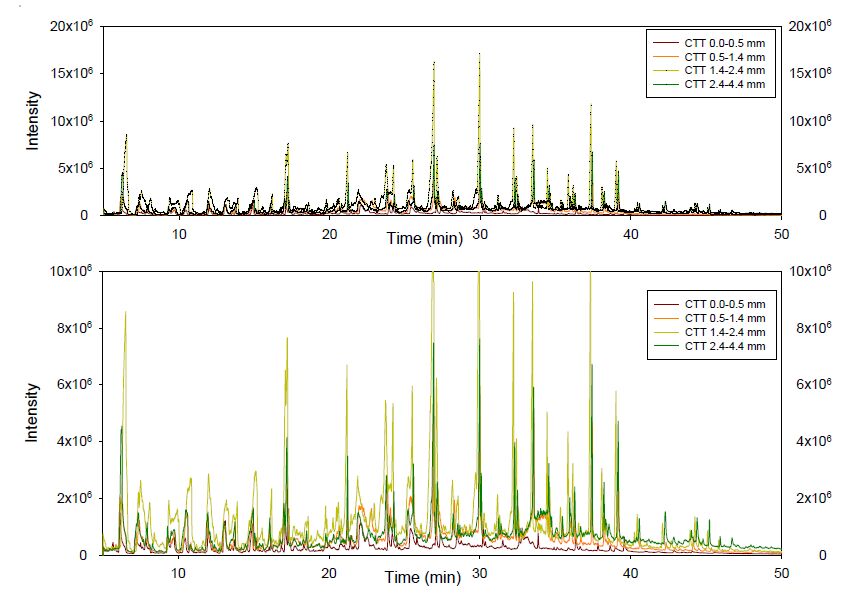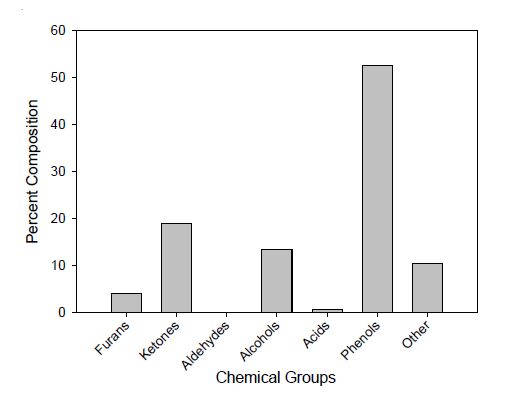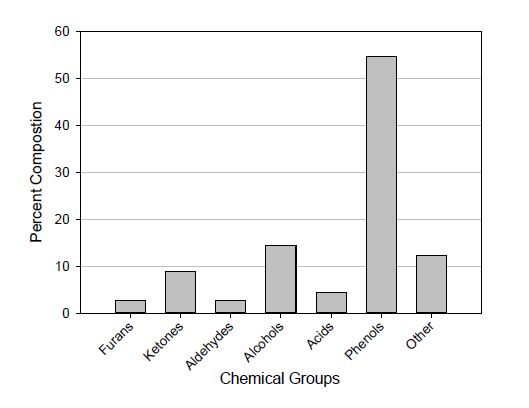In the face of fluctuating petroleum costs and a growing demand for energy, the need for an alternative and sustainable energy source has increased. A viable solution for this problem can be attained by using thermochemical conversion, pyrolysis, of existing biomass sources for the production of liquid fuels. This study focuses on the effect that biomass particle size has on the conversion of biomass into liquid pyrolysis oil. Energy cane and Chinese tallow tree biomass were pyrolyzed at 550 ℃. The particle size ranges studied were < 0.5, 0.5 to 1.4, 1.4 to 2.4 and, 2.4 to 4.4 mm. The results indicate that the range from 0.5-1.4 mm is a better range for optimizing bio-oil production while keeping water content low.
1.
Introduction
To exemplify the phenomena of compounds scientifically, researchers utilize the contraption of the diagrammatic hypothesis, it is a well-known branch of geometrical science named graph theory. This division of numerical science provides its services in different fields of sciences. The particular example in networking [1], from electronics [2], and for the polymer industry, we refer to see [3]. Particularly in chemical graph theory, this division has extra ordinary assistance to study giant and microscope-able chemical compounds. For such a study, researchers made some transformation rules to transfer a chemical compound to a discrete pattern of shapes (graph). Like, an atom represents as a vertex and the covalent bonding between atoms symbolized as edges. Such transformation is known as molecular graph theory. A major importance of this alteration is that the hydrogen atoms are omitted. Some chemical structures and compounds conversion are presented in [4,5,6].
In cheminformatics, the topological index gains attraction due to its implementations. Various topological indices help to estimate a bio-activity and physicochemical characteristics of a chemical compound. Some interesting and useful topological indices for various chemical compounds are studied in [3,7,8]. A topological index modeled a molecular graph or a chemical compound into a numerical value. Since 1947, topological index implemented in chemistry [9], biology [10], and information science [11,12]. Sombor index and degree-related properties of simplicial networks [13], Nordhaus–Gaddum-type results for the Steiner Gutman index of graphs [14], Lower bounds for Gaussian Estrada index of graphs [15], On the sum and spread of reciprocal distance Laplacian eigenvalues of graphs in terms of Harary index [16], the expected values for the Gutman index, Schultz index, and some Sombor indices of a random cyclooctane chain [17,18,19], bounds on the partition dimension of convex polytopes [20,21], computing and analyzing the normalized Laplacian spectrum and spanning tree of the strong prism of the dicyclobutadieno derivative of linear phenylenes [22], on the generalized adjacency, Laplacian and signless Laplacian spectra of the weighted edge corona networks [23,24], Zagreb indices and multiplicative Zagreb indices of Eulerian graphs [25], Minimizing Kirchhoff index among graphs with a given vertex bipartiteness, [26], asymptotic Laplacian energy like invariant of lattices [27]. Few interesting studies regarding the chemical graph theory can be found in [28,29,30,31,32].
Recently, the researchers of [33] introduced a topological descriptor and called the face index. Moreover, the idea of computing structure-boiling point and energy of a structure, motivated them to introduced this parameter without heavy computation. They computed these parameters for different models compare the results with previous literature and found approximate solutions with comparatively less computations. This is all the blessings of face index of a graph. The major concepts of this research work are elaborated in the given below definitions.
Definition 1.1. [33] Let a graph $ G = \left(V(G), E(G), F(G)\right) $ having face, edge and vertex sets notation with $ F(G), E(G), V(G), $ respectively. It is mandatory that the graph is connected, simple and planar. If $ e $ from the edge set $ E(G), $ is one of those edges which surrounds a face, then the face $ f $ from the face set $ F(G), $ is incident to the edge $ e. $ Likewise, if a vertex $ \alpha $ from the vertex set $ V(G) $ is at the end of those incident edges, then a face $ f $ is incident to that vertex. This face-vertex incident relation is symbolized here by the notation $ \alpha\sim f. $ The face degree of $ f $ in $ G $ is described as $ d(f) = \sum_{\alpha\sim f}{d\left(\alpha\right)}, $ which are elaborated in the Figure 1.
Definition 1.2. [33] The face index $ FI\left(G\right), $ for a graph $ G, $ is formulated as
In the Figure 1, we can see that there are two faces with degree $ 4, $ exactly two with five count and four with count of 6. Moreover, there is an external face with count of face degree $ 28, $ which is the count of vertices.
As the information given above that the face index is quite new and introduced in the year 2020, so there is not so much literature is available. A few recent studies on this topic are summarized here. A chemical compound of silicon carbides is elaborated with such novel definition in [34]. Some carbon nanotubes are discussed in [35]. Except for the face index, there are distance and degree-based graphical descriptors available in the literature. For example, distance-based descriptors of phenylene nanotube are studied in [36], and in [37] titania nanotubes are discussed with the same concept. Star networks are studied in [38], with the concept of degree-based descriptors. Bounds on the descriptors of some generalized graphs are discussed in [39]. General Sierpinski graph is discussed in [40], in terms of different topological descriptor aspects. The study of hyaluronic acid-doxorubicin ar found in [41], with the same concept of the index. The curvilinear regression model of the topological index for the COVID-19 treatment is discussed in [42]. For further reading and interesting advancements of topological indices, polynomials of zero-divisor structures are found in [43], zero divisor graph of commutative rings [44], swapped networks modeled by optical transpose interconnection system [45], metal trihalides network [46], some novel drugs used in the cancer treatment [47], para-line graph of Remdesivir used in the prevention of corona virus [48], tightest nonadjacently configured stable pentagonal structure of carbon nanocones [49]. In order to address a novel preventive category (P) in the HIV system known as the HIPV mathematical model, the goal of this study is to offer a design of a Morlet wavelet neural network (MWNN) [50].
In the next section, we discussed the newly developed face index or face-based index for different chemical compounds. Silicate network, triangular honeycomb network, carbon sheet, polyhedron generalized sheet, and generalized chain of silicate network are studied with the concept of the face-based index. Given that the face index is more versatile than vertex degree-based topological descriptors, this study will aid in understanding the structural characteristics of chemical networks. Only the difficulty authors will face to compute the face degree of a generalized network or structure, because it is more generalized version and taking degree based partition of edges into this umbrella of face index.
2.
Results on the face index of chemical networks
Silicates are formed when metal carbonates or metal oxides react with sand. The $ SiO_4, $ which has a tetrahedron structure, is the fundamental chemical unit of silicates. The central vertex of the $ SiO_4 $ tetrahedron is occupied by silicon ions, while the end vertices are occupied by oxygen ions [51,52,53]. A silicate sheet is made up of rings of tetrahedrons that are joined together in a two-dimensional plane by oxygen ions from one ring to the other to form a sheet-like structure. The silicate network $ SL_{n} $ symbol, where $ {n} $ represents the total number of hexagons occurring between the borderline and center of the silicate network $ SL_{n}. $ The silicate network of dimension one is depicted in Figure 2. It contain total $ 3{n}\left(5{n}+1\right) $ vertices are $ 36{n}^2 $ edges. Moreover, the result required is detailed are available in Table 1.
Theorem 2.1. Let $ SL_{n} $ be the silicate network of dimension $ n\geq1. $ Then the face index of $ SL_{n} $ is
Proof. Consider $ SL_{n} $ the graph of silicate network with dimension $ {n}. $ Suppose $ f_{i} $ denotes the faces of graph $ SL_{n} $ having degree $ i. $ that is, $ d(f_{i}) = \sum_{\alpha\sim f_{i}}{d\left(\alpha\right)} = i $ and $ |f_{i}| $ denotes the number of faces with degree $ i. $ The graph $ SL_{n} $ contains three types of internal faces $ f_{12}, $ $ f_{15}, $ $ f_{36}, $ and single external face which is usually denoted by $ f^{\infty}. $
If $ SL_{n} $ has one dimension then sum of degree of vertices incident to the external face is $ 144 $ and when $ SL_{n} $ has two dimension then sum of degree of incident vertices to the external face is $ 204 $ whenever $ SL_{n} $ has three dimension then sum of degree of incident vertices to the external face is $ 264. $ Similarly, $ SL_{n} $ has $ n- $dimension then sum of degree of incident vertices to the external face is $ 60n+84. $
The number of internal faces with degree in each dimension is mentioned in Table 1.
By using the definition of face index $ FI $ we have
Hence, this is our required result.
A chain silicate network of dimension $ (m, n) $ is symbolized as $ CSL\left(m, n\right) $ which is made by arranging $ (m, n) $ tetrahedron molecules linearly. A chain silicate network of dimension $ (m, n) $ with $ m, n\geq1 $ where $ m $ denotes the number of rows and each row has $ n $ number of tetrahedrons. The following theorem formulates the face index $ FI $ for chain silicate network.
Theorem 2.2. Let $ CSL\left(m, n\right) $ be the chain of silicate network of dimension $ m, n\geq1. $ Then the face index $ FI $ of the graph $ CSL\left(m, n\right) $ is
Proof. Let $ CSL\left(m, n\right) $ be the graph of chain silicate network of dimension $ (m, n) $ with $ m, n\geq1 $ where $ m $ represents the number of rows and $ n $ is the number of tetrahedrons in each row. A graph $ CSL\left(m, n\right) $ for $ m = 1 $ contains three type of internal faces $ f_{9}, \ f_{12} $ and $ f_{15} $ with one external face $ f^{\infty}. $ While for $ m\geq2, $ it has four type of internal faces $ f_{9}, \ f_{12}, \ f_{15} $ and $ f_{36} $ with one external face $ f^{\infty}. $ We want to evaluate the algorithm of face index $ FI $ for chain silicate network. We will discuss it in two different cases.
Case 1: When $ CSL\left(m, n\right) $ has one row $ (m = 1) $ with $ n $ number of tetrahedrons as shown in the Figure 3.
The graph has three type of internal faces $ f_{9}, \ f_{12} $ and $ f_{15} $ with one external face $ f^{\infty}. $ The sum of degree of incident vertices to the external face is $ 9n $ and number of faces are $ |f_{9}| = 2, \ |f_{12}| = 2n $ and $ |f_{15}| = n-2. $ Now the face index $ FI $ of the graph $ CSL\left(m, n\right) $ is given by
Case 2: When $ CSL\left(m, n\right) $ has more than one rows $ (m\neq1) $ with $ n $ number of tetrahedrons in each row as shown in the Figure 4.
The graph has four type of internal faces $ f_{9}, \ f_{12}, \ f_{15} $ and $ f_{36} $ with one external face $ f^{\infty}. $ The sum of degree of incident vertices to the external face is
The number of faces are $ |f_{9}|, \ |f_{12}|, \ f_{15} $ and $ |f_{36}| $ are given by
Now the face index $ FI $ of the graph $ CSL\left(m, n\right) $ is given by
After some mathematical simplifications, we can get
There are three regular plane tessellations known to exist, each constituted from the same type of regular polygon: triangular, square, and hexagonal. The triangular tessellation is used to define the hexagonal network, which is extensively studied in [54]. A dimensioned hexagonal network $ TH_{k} $ has $ 3{k}^2-3{k}+1 $ vertices and $ 9{k}^2-15{k}+6 $ edges, where $ {k} $ is the number of vertices on one side of the hexagon. It has $ 2{k}-2 $ diameter. There are six vertices of degree three that are referred to as corner vertices. Moreover, the result required detailed are available in the Table 2.
Theorem 2.3. Let $ TH_{k} $ be the triangular honeycomb network of dimension $ k\geq1. $ Then the face index of graph $ TH_{k} $ is
Proof. Consider $ TH_{k} $ be a graph of triangular honeycomb network. The graph $ TH_{1} $ has one internal and only one external face while graph $ TH_{k} $ with $ k\geq2, $ contains four types of internal faces $ f_{12}, $ $ f_{14}, $ $ f_{17}, $ and $ f_{18} $ with one external face $ f^{\infty}. $
For $ TH_{1} $ the sum of degree of incident vertices to the external face is $ 18 $ and in $ TH_{2} $ the sum of degree of incident vertices to the external face is $ 66. $ Whenever the graph $ TH_{3}, $ the sum of degree of incident vertices to the external face is $ 114. $ Similarly, for $ TH_{k} $ has $ n- $dimension then sum of degree of incident vertices to the external face is $ 48k-30. $
The number of internal faces with degree in each dimension is given in Table 2.
By using the definition of face index $ FI $ we have
Hence, this is our required result.
Given carbon sheet in the Figure 6, is made by grid of hexagons. There are few types of carbon sheets are given in [55,56]. The carbon sheet is symbolize as $ HCS_{{m}, {n}}, $ where $ {n} $ represents the total number of vertical hexagons and $ {m} $ denotes the horizontal hexagons. It contain total $ 4{m}{n}+2\left({n}+{m}\right)-1 $ vertices and $ 6{n}{m}+2{m}+{n}-2 $ edges. Moreover, the result required detailed are available in Tables 3 and 4.
Theorem 2.4. Let $ HCS_{{m}, {n}} $ be the carbon sheet of dimension $ \left({m}, {n}\right) $ and $ {m}, {n}\geq2. $ Then the face index of $ HCS_{{m}, {n}} $ is
Proof. Consider $ HCS_{{m}, {n}} $ be the carbon sheet of dimension $ \left({m}, {n}\right) $ and $ {m}, {n}\geq2. $ Let $ {f}_{i} $ denotes the faces of graph $ HCS_{{m}, {n}} $ having degree $ {i}, $ which is $ d(f_{i}) = \sum_{\alpha\sim f_{i}}{d\left(\alpha\right)} = i, $ and $ |f_{i}| $ denotes the number of faces with degree $ i. $ A graph $ HCS_{{m}, {n}} $ for a particular value of $ {m} = 2 $ contains three types of internal faces $ {f}_{15}, $ $ {f}_{16}, $ $ {f}_{17} $ and $ {f}_{18} $ with one external face $ {f}^{\infty}. $ While for the generalize values of $ {m}\geq3, $ it contain four types of internal faces $ {f}_{15}, $ $ {f}_{16} $ and $ {f}_{17} $ with one external face $ {f}^{\infty} $ in usual manner. For the face index of generalize nanotube, we will divide into two cases on the values of $ {m}. $
Case 1: When $ HCS_{{m}, {n}} $ has one row or $ HCS_{{2}, {n}}. $
A graph $ HCS_{{m}, {n}} $ for a this particular value of $ {m} = 2 $ contains three types of internal faces $ \left|{f}_{15}\right| = 3, $ $ \left|{f}_{16}\right| = 2\left({n}-1\right) $ and $ \left|{f}_{18}\right| = {n}-1 $ with one external face $ {f}^{\infty}. $ For the face index of carbon sheet, details are given in the Table 3. Now the face index $ FI $ of the graph $ NT_{{2}, {n}} $ is given by
Case 2: When $ HCS_{{m}, {n}} $ has $ {m}\geq3 $ rows.
A graph $ HCS_{{m}, {n}} $ for generalize values of $ {m}\geq3 $ contains four types of internal faces $ \left|{f}_{15}\right| = 2, $ $ \left|{f}_{16}\right| = 2{n}, $ $ \left|{f}_{17}\right| = 2{m}-5 $ and $ \left|{f}_{18}\right| = 2{m}{n}-2{m}-3{n}+3 $ with one external face $ {f}^{\infty}. $ For the face index of carbon sheet, details are given in the Table 4. Now the face index $ FI $ of the graph $ NT_{{m}, {n}} $ is given by
Given structure of polyhedron generalized sheet of $ C^{\ast}_{28} $ in the Figure 7, is made by generalizing a $ C^{\ast}_{28} $ polyhedron structure which is shown in the Figure 8. This particular structure of $ C^{\ast}_{28} $ polyhedron are given in [57]. The polyhedron generalized sheet of $ C^{\ast}_{28} $ is as symbolize $ PHS_{{m}, {n}}, $ where $ {n} $ represents the total number of vertical $ C^{\ast}_{28} $ polyhedrons and $ {m} $ denotes the horizontal $ C^{\ast}_{28} $ polyhedrons. It contain total $ 23{n}{m}+3{n}+2{m} $ vertices and $ 33{n}{m}+{n}+{m} $ edges. Moreover, the result required detailed are available in Tables 3 and 5.
Theorem 2.5. Let $ PHS_{{m}, {n}} $ be the polyhedron generalized sheet of $ C^{\ast}_{28} $ of dimension $ \left({m}, {n}\right) $ and $ {m}, {n}\geq1. $ Then the face index of $ PHS_{{m}, {n}} $ is
Proof. Consider $ PHS_{{m}, {n}} $ be the polyhedron generalized sheet of $ C^{\ast}_{28} $ of dimension $ \left({m}, {n}\right) $ and $ {m}, {n}\geq1. $ Let $ {f}_{i} $ denotes the faces of graph $ PHS_{{m}, {n}} $ having degree $ {i}, $ which is $ d(f_{i}) = \sum_{\alpha\sim f_{i}}{d\left(\alpha\right)} = i, $ and $ |f_{i}| $ denotes the number of faces with degree $ i. $ A graph $ PHS_{{m}, {n}} $ for the generalize values of $ {m}, {n}\geq1, $ it contain seven types of internal faces $ {f}_{14}, {f}_{15}, {f}_{16}, {f}_{17}, {f}_{18}, {f}_{20} $ and $ {f}_{35} $ with one external face $ {f}^{\infty} $ in usual manner. For the face index of polyhedron generalized sheet, details are given in the Table 5.
A graph $ PHS_{{m}, {n}} $ for generalize values of $ {m}, {n}\geq1 $ contains seven types of internal faces $ \left|{f}_{14}\right| = 2{n}+{m}, $ $ \left|{f}_{15}\right| = 2, $ $ \left|{f}_{16}\right| = 4{n}{m}-2, $ $ \left|{f}_{17}\right| = 2\left({m}-1\right), $ $ \left|{f}_{18}\right| = 2{n}{m}-2\left({m}+{n}\right)+2, $ $ \left|{f}_{20}\right| = 2{n}{m}-2{m}{n}-{m}, $ and $ \left|{f}_{35}\right| = 2{m}{n}-{m}-2{n}+1 $ with one external face $ {f}^{\infty}. $ Now the face index $ FI $ of the graph $ PHS_{{m}, {n}} $ is given by
3.
Conclusions
With the advancement of technology, types of equipment and apparatuses of studying different chemical compounds are evolved. But topological descriptors or indices are still preferable and useful tools to develop numerical science of compounds. Therefore, from time to time new topological indices are introduced to study different chemical compounds deeply. In this study, we discussed a newly developed tool of some silicate type networks and generalized sheets, carbon sheet, polyhedron generalized sheet, with the face index concept. It provides numerical values of these networks based on the information of faces. It also helps to study physicochemical characteristics based on the faces of silicate networks.
Acknowledgements
M. K. Jamil conceived of the presented idea. K. Dawood developed the theory and performed the computations. M. Azeem verified the analytical methods, R. Luo investigated and supervised the findings of this work. All authors discussed the results and contributed to the final manuscript.
This work was supported by the National Science Foundation of China (11961021 and 11561019), Guangxi Natural Science Foundation (2020GXNSFAA159084), and Hechi University Research Fund for Advanced Talents (2019GCC005).
Conflicts of interest
The authors declare that they have no conflicts of interest.










 DownLoad:
DownLoad:
